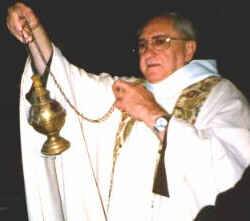 Deaths
which occurred on a December 07: Deaths
which occurred on a December 07:
2002 Father William Gulas, O.F.M., 68 [photo >],
shot in the chest and hit on the head by Franciscan novice brother Daniel
Montgomery, 37, who then sets fire to the rectory of St.
Stanislaus Catholic church in Cleveland, where he was an assistant since
the summer of 2002, and Father Gulas was the pastor since 1993. Montgomery,
a novice since 1995, had been dismissed from the Franciscans a few days
earlier.
2002 Hodaya Kedem-Pimstein, 22 months, drowned in her bath
by her father Eli Pimstein, in the Kiryat Yover neighborhood of Jerusalem,
who then buries her in a hole he had prepared in a forest near the Jerusalem-area
moshavim of Ora and Aminadav. Her body is discovered and her father arrested
on 10 December 2002. He confesses.
2002:: 17 persons in Mymenshingh, Bangladesh, as terrorist bombs
explode within 30 minutes of each other starting at 18:00, in four
movie theaters, crowded with Muslims celebrating the end-of-Ramadan Eid-al-Fitr.
10 persons died instantly, the others on their way to or at the hospital.
Some 300 are injured.
1989 Hans Heinrich Ernst Hartung, German-born French painter born
on 21 September 1904. — MÁS
SOBRE HARTUNG EN ART “4” SEPTEMBER
— LINKS
— Lines
and Curves (1956)
1988 More than 25'000 earthquake
victims in Armenia ^ top ^
In the Soviet Union, an earthquake
of a 6.9 magnitude on the Richter scale hits northwestern Armenia,
affecting an area eighty kilometers in diameter. Four minutes
later, the initial earthquake is followed by a powerful 5.8
magnitude aftershock. More than twenty towns and 342 villages
are affected, and fifty-eight of them are heavily damaged. Spitak,
a major population center, was almost totally destroyed. The
earthquake kills more than 25'000 people, injures at least 15'000,
and leaves some 500'000 Armenians homeless. Direct economic
losses are estimated at fourteen billion dollars. With the USSR
nearing economic collapse, rebuilding would be slow.
1985 Robert
Graves, English poet, novelist, mythographer, critic, historian,
dies in Deya, Majorca, Spain. Author of I, Claudius and Claudius
the God. For those with Graves concerns.
1985 Potter Stewart, 70, retired US Supreme Court Justice, in
New Hampshire.
1983 Edgar Graham member of N Ireland Assembly, shot dead by IRA
1982 Charles Brooks, Jr., in
first execution by lethal injection ^ top ^
The first execution by lethal
injection takes place at the state penitentiary in Huntsville,
Texas. Charles Brooks, Jr., a Black convicted of murdering used
car salesman David Gregory in Huntsville Texas in 1976, receives
an intravenous injection of sodium pentathol (the barbiturate
known as a "truth serum" when administered in lesser doses),
beginning at 00:07. He is certified dead at 00.16.
Texas adopted the lethal
injection procedure as a more humane method of carrying
out its death sentences, as opposed to the standard techniques
of death by gas, electrocution, or hanging. Over the next decade,
thirty-two states, the federal government, and the US military
all utilize the lethal injection method, although Texas, which
consistently performs more than one-third of all US executions,
remains the statistical leader. After several years of practical
development, Texas and most other states adopt a lethal injection
procedure in which three separate drugs are injected successively
into the convict's bloodstream. The first drug, sodium thiopental,
a barbiturate, renders the prisoner unconscious, the next, pancuronium
bromide, a muscle relaxant, paralyses the diaphragm and lungs,
and the third, potassium chloride, causes cardiac arrest and
ensures the prisoner's death.
The state has the right and duty
to protect society and punish criminals. But in administering
the Death Penalty, we all become part of the violence.
Killing is killing. Executions are executions regardless
of how they are carried out. Lethal injection has been represented
to be a more humane way to perform an execution but it is no
more humane than any other method. It has been said that it
is a less gruesome way to perform executions but it is not.
It may be less gruesome to witness, we may not hear or smell
or see burning flesh that goes along with electrocution, but
the result is no less gruesome to the condemned prisoner. And
there is evidence to suggest that the anxiety that accompanies
lethal injection is greater than that of electrocution.
Killing is barbaric regardless of how it is done. Each
time we come up with a new form of execution that is supposed
to be more efficient, quicker, or more painless, its predecessor
is regarded as barbaric. Whether it is being drawn and quartered,
death by the guillotine, hanging, firing squad, gas chamber
or electrocution the result is always the same. Each time we
take a life through an execution we diminish ourselves as a
people. Killing people to show that killing is wrong serves
only to perpetuate the cycle of violence. The contradiction
is Capital Punishment reflects a desire for revenge, but at
the same time, we want it sanitized.
Lethal injection is a corruption and exploitation of medical
technology. It involves a medical procedure, requires medical
training to be able administer, and requires medical knowledge
in order to prepare the drugs involved. Moreover, lethal injection
is a violation of the Hippocratic Oath.
The AMA's Code of Medical Ethics (1994 Edition) states:
"A physician, as a member of a profession dedicated to preserving
life when there is hope of doing so, should not be a participant
in a legally authorized execution. In the case where the method
of execution is lethal injection, the following actions by the
physician would also constitute physician participation in execution:
selecting injection sites; starting intravenous lines as a port
for a lethal injection device; prescribing, preparing, administering,
or supervising injection drugs or their doses or types; inspecting,
testing, or maintaining lethal injection devices; and consulting
with or supervising lethal injection personnel.
Any bill that does go forward should have a provision that
no licensed medical personnel should partake in lethal injection
execution. Conscience clauses for health care employees and
employees should also be included.
Proponents of lethal injection have claimed that it is
quick and painless. Reportedly, the first person to be executed
by lethal injection, Charles Brooks (1982--Texas), was alive
for seven minutes after the injection; James Autry (1984--Texas)
lived for a full fifteen minutes, was conscious for the first
thirteen minutes, and at one point during that process cried
out in pain.
Experts testify that there is no certain way to know
how long a lethal injection will take or how much of a dosage
is required. Lethal injection involves many variables. Human
tolerance levels vary; vascular condition plays a role; the
proper administration of the drug is a factor. The drugs involved
decrease the respiratory and heart beat gradually and it is
difficult to tell exactly when the life functions have ceased.
Whether it is by needle or electrocution, killing is killing.
Lethal injection may be easier to accept by society and more
comfortable for us, but the taking of life, even if guilty,
is something that should not rest easily on our minds. The reality
of the terror of executions is something about which we should
always remain aware. http://www.flacathconf.org/B3/Legses98/Pstnpr98/Let298pp.htm |
1977 Peter Goldmark, television
and recording pioneer. ^ top ^
Goldmark was born in Budapest
and later immigrated to the United States. As an engineer at
Columbia Broadcasting Systems Laboratory, he devised a color
television system and later the LP (long playing) record album,
which transformed the recording industry. Goldmark's color television,
first demonstrated in 1940 and approved for commercial use after
World War II, used a rotating, three-color disk to project color
images. Although all-electronic color television quickly replaced
Goldmark's mechanical system, closed-circuit television manufacturers
continued to use Goldmark's design. In 1948, Goldmark developed
the LP, which could carry as much music as six 78-rpm records.
Later, as vice president of CBS, Goldmark developed a system
that allowed the US Lunar Orbiter to transmit photographs
from the Moon to the Earth. |
1972 Assailant shot by bodyguards of Imelda Marcos, wife of Philippine
President Ferdinand E. Marcos, whom he stabbed and seriously wounded.
1970 Ruben Lucius "Rube"
Goldberg, 87, in New York City. US cartoonist who satirized the
American preoccupation with technology. His name became synonymous with
any simple process made outlandishly complicated, such as by the preposterous
machines he drew.One of his hundreds of pictorial inventions was an automatic
stamp licker activated by a dwarf robot who overturned a can of ants
onto a page of postage stamps, gumside up. They were then licked up by
an anteater who had been starved for three days. — LINKS
— "Baseball
and business can go hand in hand" for College Humor (1930,
13x44cm) — Pencil
Sharpener — How
to Keep Shop Windows Clean — Simplified
Pencil Sharpener — Dodging
Bill Collectors — Keep
from Forgetting to Mail your Wife's Letter — Picture
Snapping Machine — Safety
Device for Walking on Icy Pavements — How
to Keep the Boss from Knowing you are Late for Work — How
to Tee up a Golf Ball Without Bending Over — Our
Special Never-Miss Putter — Golf
Inventions
1964 Hundreds of South Vietnamese
and 2 US advisers, in Viet Cong attack. ^ top ^
The situation worsens in South
Vietnam, as the Viet Cong attack and capture the district headquarters
at An Lao and much of the surrounding valley 300 miles northeast
of Saigon. South Vietnamese troops regained control only after
reinforcements were airlifted into the area by US helicopters.
During the course of the action, two US advisors were killed.
There were over 300 South Vietnamese casualties and as many
as 7000 villagers were temporarily forced to abandon their homes.
In response, Ambassador Maxwell
Taylor, who had just returned from Washington, held a series
of conferences with Premier Tran Van Huong, General Nguyen Khanh,
and other South Vietnamese leaders. Taylor told them that the
United States would provide additional financial aid to help
stabilize the worsening situation in the countryside. It was
agreed that the funds would be used to strengthen South Vietnam's
military forces (which South Vietnam agreed to increase by 100'000
men) and to "further economic assistance for a variety of reforms
of industrial, urban, and rural development.” Nothing was
said during these discussions about President Lyndon B. Johnson's
plans to commence the bombing of North Vietnam, which had been
decided during Taylor's meeting with the president and his advisers
when Taylor was in Washington earlier in December. |
1952 Hundreds of persons in London, choked by the Great Killer Fog
which settled on 05 December and fed by intensified millions of home coal
fires, as the temperature drops, has worsened to the point that, now, visibility
is reduced to 30 cm and breathing is oppressive.
1952 Some 500 more choked by
the Great Killer Smog in London.
^top^
With weather colder
than usual a fog had formed on 05 October over London under a stagnant
inversion, and loaded by coal smoke and other pollutants had thickened
by evening reducing the visibility to a few meters. On 06 October
some 500 persons had already died from the smog. On 07 October another
500 die, choked by the coal smoke and industrial pollutants in the
thick smog. In central London, the visibility falls to less than 50
meters. At Heathrow Airport, visibility remains below ten meters.
The smog would persist until blown away by winds on 09 December.
The term 'smog' meaning 'fog intensified
by smoke' was coined by H.A. Des Voeux, who first used it in 1905
to describe the conditions of fuliginous (sooty) fog that occurred
all too often over British urban areas. It was popularized in 1911
when Des Voeux presented to the Manchester Conference of the Smoke
Abatement League of Great Britain a report on the deaths that occurred
in Glasgow and Edinburgh in the Autumn of 1909 as a consequence of
smoke-laden fogs.
As long ago as the 13th century, air
pollution was recognized as a public-health problem in the cities
and large towns of the British Isles, and the burning of coal was
identified as the principal source. Later, in his Fumifugium,
or the Inconvenience of the Aer and Smoake of London Dissipated,
published in 1661, John Evelyn wrote of the 'Hellish and dismall cloud
of sea-coale' that lay over London and recommended that all noisome
trades be banished from the city. The authorities did not, however,
take his advice. The burning of coal continued and the pall of soot
over London grew worse.
The industrial revolution brought factory
chimneys that belched gases and huge numbers of particles into the
atmosphere. Some of these particles caused lung and eye irritations.
Others were poisonous. All were potentially condensation nuclei. From
the gases, corrosive acids were formed, notably sulphuric acid, which
is produced when sulphur dioxide combines with oxygen and water.
As if it were not enough that they
brought on agues, rheumatism and fevers and carried particles of soot
from coal fires, the fogs of the British Isles now became even more
unpleasant, for the noxious emissions from factory chimneys gave them
an acrid taste, an unpleasant odor and a dirty yellow or brown color.
These fogs, so different from the clean white fogs of country areas,
came to be known as 'pea soupers', not only in London but also in
other industrial areas of the British Isles. The particles in the
atmosphere made buildings dirty and the acids attacked ironwork, stonework
and fabrics.
There were killer smogs before 1912.
On 27 December 1813, for example, fog was so dense that the Prince
Regent, having set out for Hatfield House, was forced to turn back
at Kentish Town. The fog persisted for almost a week and on one day
was so thick that the mail coach from London to Birmingham took seven
hours to reach Uxbridge. Contemporary accounts tell of the fog being
so thick that the other side of the street could not be seen. They
also tell of the fog bearing a distinct smell of coal tar.
After a similar fog during the week
of 07 to 13 December 1873, the death rate in the Administrative County
of London was 40% above normal. Marked increases in death rate occurred,
too, after the notable fogs of January 1880, February 1882, December
1891, December 1892 and November 1948. The worst affected area of
London was usually the East End, where the density of factories and
domestic dwellings was greater than almost anywhere else in the capital.
The area was also low-lying, which inhibited fog dispersal. |
1947 Tristán Bernard, escritor francés.
1946: 119 persons, including W. Frank Winecoff, founder of the
Winecoff Hotel in Atlanta, in which they are killed by a fire.
1942 Manuel García Morente, filósofo
español. |
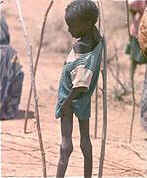 On
a December 07:
On
a December 07: 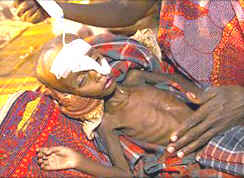 2002
At the Ethiopian government's Disaster Prevention and Preparedness Commission's
emergency appeal, Prime Minister Meles Zenawi tells diplomats and UN officials
that, in his country, there is a "chronic, predictable underlying structural
problem that needs to be addressed." and he appeals for help ho feed
the 11.3 million of the 62 million Ethiopians who face severe food shortages.
Ethiopia,
with an average annual income of $108, is one of the world's 10 poorest
countries and is regularly beset by serious food shortages. Between 1984
and 1985 famine devastated the nation, and in 2000 an estimated 10 million
persons needed food aid. In “normal” years some four million
Ethiopians
need food aid to survive. Ethiopia is also still trying to overcome
the effects of a 2 1/2-year border war with Eritrea which ended in December
2000. Worse-than-usual harvests in 2002 have accentuated the problem. In
2002, throughout
Africa more than 30 million persons are in danger of severe malnutrition
or starvation because of food shortages caused by drought, poor management
and corruption. [< A starving child is fed through a tube at
a temporary feeding center in the town of Gode in April 2000].
2002
At the Ethiopian government's Disaster Prevention and Preparedness Commission's
emergency appeal, Prime Minister Meles Zenawi tells diplomats and UN officials
that, in his country, there is a "chronic, predictable underlying structural
problem that needs to be addressed." and he appeals for help ho feed
the 11.3 million of the 62 million Ethiopians who face severe food shortages.
Ethiopia,
with an average annual income of $108, is one of the world's 10 poorest
countries and is regularly beset by serious food shortages. Between 1984
and 1985 famine devastated the nation, and in 2000 an estimated 10 million
persons needed food aid. In “normal” years some four million
Ethiopians
need food aid to survive. Ethiopia is also still trying to overcome
the effects of a 2 1/2-year border war with Eritrea which ended in December
2000. Worse-than-usual harvests in 2002 have accentuated the problem. In
2002, throughout
Africa more than 30 million persons are in danger of severe malnutrition
or starvation because of food shortages caused by drought, poor management
and corruption. [< A starving child is fed through a tube at
a temporary feeding center in the town of Gode in April 2000].  Deaths
Deaths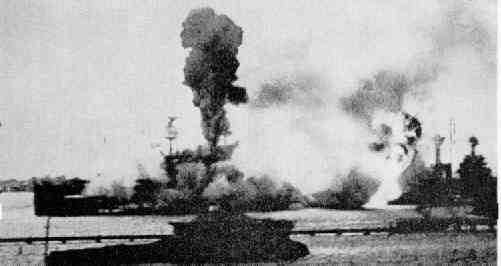
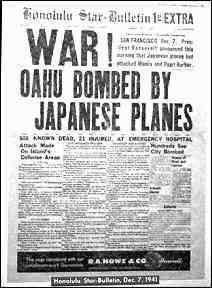
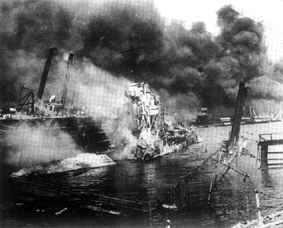 Les
Japonais attaquent Pearl Harbor
Les
Japonais attaquent Pearl Harbor